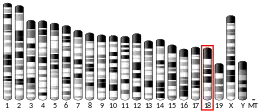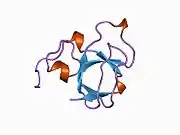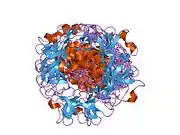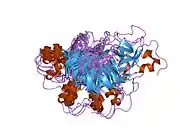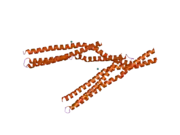Myc box-dependent-interacting protein 1, also known as Bridging Integrator-1 and Amphiphysin-2 is a protein that in humans is encoded by the BIN1 gene.[5][6][7]
This gene encodes several isoforms of a nucleocytoplasmic adaptor protein, one of which was initially identified as a MYC-interacting protein with features of a tumor suppressor.
Isoforms that are expressed in the central nervous system may be involved in synaptic vesicle endocytosis and may interact with dynanim, synaptojanin, endophilin, and clathrin.[8]
Isoforms that are expressed in muscle and ubiquitously expressed isoforms localize to the cytoplasm and nucleus and activate a caspase-independent apoptotic process.[8]
Studies in mouse suggest that this gene plays an important role in cardiac muscle development. Alternate splicing of the gene results in ten transcript variants encoding different isoforms. Aberrant splice variants expressed in tumor cell lines have also been described.[8]
Clinical significance
In humans, mutations in BIN1 have been associated with skeletal myopathies including centronuclear myopathy causing muscle weakness[7] and myotonic dystrophy causing progressive muscle wasting, myotonia, cataracts, and heart conduction defects.[9] An association has also been found between BIN1 mutations and Alzheimer's disease.[9] Knockdown of BIN1 produces a cardiomyopathy phenotype in zebrafish,[10] and in sheep BIN1 may be responsible for the loss of T-tubules seen in heart failure.[11]
Interactions
BIN1 has been shown to interact with Phospholipase D1,[12] SNX4[13] and PLD2.[12]
References
- 1 2 3 GRCh38: Ensembl release 89: ENSG00000136717 - Ensembl, May 2017
- 1 2 3 GRCm38: Ensembl release 89: ENSMUSG00000024381 - Ensembl, May 2017
- ↑ "Human PubMed Reference:". National Center for Biotechnology Information, U.S. National Library of Medicine.
- ↑ "Mouse PubMed Reference:". National Center for Biotechnology Information, U.S. National Library of Medicine.
- ↑ Negorev D, Riethman H, Wechsler-Reya R, Sakamuro D, Prendergast GC, Simon D (January 1997). "The Bin1 gene localizes to human chromosome 2q14 by PCR analysis of somatic cell hybrids and fluorescence in situ hybridization". Genomics. 33 (2): 329–31. doi:10.1006/geno.1996.0205. PMID 8725406.
- ↑ Sakamuro D, Elliott KJ, Wechsler-Reya R, Prendergast GC (October 1996). "BIN1 is a novel MYC-interacting protein with features of a tumour suppressor". Nat Genet. 14 (1): 69–77. doi:10.1038/ng0996-69. PMID 8782822. S2CID 21484402.
- 1 2 Nicot AS, Toussaint A, Tosch V, Kretz C, Wallgren-Pettersson C, Iwarsson E, Kingston H, Garnier JM, Biancalana V, Oldfors A, Mandel JL, Laporte J (August 2007). "Mutations in amphiphysin 2 (BIN1) disrupt interaction with dynamin 2 and cause autosomal recessive centronuclear myopathy". Nat Genet. 39 (9): 1134–9. doi:10.1038/ng2086. PMID 17676042. S2CID 16861439.
- 1 2 3 "Entrez Gene: BIN1 bridging integrator 1".
- 1 2 Prokic I, Cowling BS, Laporte J (May 2014). "Amphiphysin 2 (BIN1) in physiology and diseases". Journal of Molecular Medicine. 92 (5): 453–463. doi:10.1007/s00109-014-1138-1. ISSN 1432-1440. PMID 24590001. S2CID 14038898.
- ↑ Hong T, Smyth JW, Chu KY, Vogan JM, Fong TS, Jensen BC, Fang K, Halushka MK, Russell SD (May 2012). "BIN1 is reduced and Cav1.2 trafficking is impaired in human failing cardiomyocytes". Heart Rhythm. 9 (5): 812–820. doi:10.1016/j.hrthm.2011.11.055. ISSN 1556-3871. PMC 3306544. PMID 22138472.
- ↑ Caldwell JL, Smith CE, Taylor RF, Kitmitto A, Eisner DA, Dibb KM, Trafford AW (2014-12-05). "Dependence of cardiac transverse tubules on the BAR domain protein amphiphysin II (BIN-1)". Circulation Research. 115 (12): 986–996. doi:10.1161/CIRCRESAHA.116.303448. ISSN 1524-4571. PMC 4274343. PMID 25332206.
- 1 2 Lee C, Kim S R, Chung J K, Frohman M A, Kilimann M W, Rhee S G (June 2000). "Inhibition of phospholipase D by amphiphysins". J. Biol. Chem. 275 (25): 18751–8. doi:10.1074/jbc.M001695200. ISSN 0021-9258. PMID 10764771.
- ↑ Leprince C, Le Scolan Erwan, Meunier Brigitte, Fraisier Vincent, Brandon Nathalie, De Gunzburg Jean, Camonis Jacques (May 2003). "Sorting nexin 4 and amphiphysin 2, a new partnership between endocytosis and intracellular trafficking". J. Cell Sci. 116 (Pt 10): 1937–48. doi:10.1242/jcs.00403. ISSN 0021-9533. PMID 12668730.
Further reading
- Andersson B, Wentland MA, Ricafrente JY, et al. (1996). "A "double adaptor" method for improved shotgun library construction". Anal. Biochem. 236 (1): 107–13. doi:10.1006/abio.1996.0138. PMID 8619474.
- Yu W, Andersson B, Worley KC, et al. (1997). "Large-Scale Concatenation cDNA Sequencing". Genome Res. 7 (4): 353–8. doi:10.1101/gr.7.4.353. PMC 139146. PMID 9110174.
- Leprince C, Romero F, Cussac D, et al. (1997). "A new member of the amphiphysin family connecting endocytosis and signal transduction pathways". J. Biol. Chem. 272 (24): 15101–5. doi:10.1074/jbc.272.24.15101. PMID 9182529.
- Butler MH, David C, Ochoa GC, et al. (1997). "Amphiphysin II (SH3P9; BIN1), a Member of the Amphiphysin/Rvs Family, Is Concentrated in the Cortical Cytomatrix of Axon Initial Segments and Nodes of Ranvier in Brain and around T Tubules in Skeletal Muscle". J. Cell Biol. 137 (6): 1355–67. doi:10.1083/jcb.137.6.1355. PMC 2132527. PMID 9182667.
- Ramjaun AR, Micheva KD, Bouchelet I, McPherson PS (1997). "Identification and characterization of a nerve terminal-enriched amphiphysin isoform". J. Biol. Chem. 272 (26): 16700–6. doi:10.1074/jbc.272.26.16700. PMID 9195986.
- Tsutsui K, Maeda Y, Tsutsui K, et al. (1997). "cDNA cloning of a novel amphiphysin isoform and tissue-specific expression of its multiple splice variants". Biochem. Biophys. Res. Commun. 236 (1): 178–83. doi:10.1006/bbrc.1997.6927. PMID 9223448.
- McMahon HT, Wigge P, Smith C (1997). "Clathrin interacts specifically with amphiphysin and is displaced by dynamin". FEBS Lett. 413 (2): 319–22. doi:10.1016/S0014-5793(97)00928-9. PMID 9280305. S2CID 42520828.
- Micheva KD, Ramjaun AR, Kay BK, McPherson PS (1997). "SH3 domain-dependent interactions of endophilin with amphiphysin". FEBS Lett. 414 (2): 308–12. doi:10.1016/S0014-5793(97)01016-8. PMID 9315708. S2CID 21328416.
- Micheva KD, Kay BK, McPherson PS (1997). "Synaptojanin forms two separate complexes in the nerve terminal. Interactions with endophilin and amphiphysin". J. Biol. Chem. 272 (43): 27239–45. doi:10.1074/jbc.272.43.27239. PMID 9341169.
- Wigge P, Köhler K, Vallis Y, et al. (1997). "Amphiphysin Heterodimers: Potential Role in Clathrin-mediated Endocytosis". Mol. Biol. Cell. 8 (10): 2003–15. doi:10.1091/mbc.8.10.2003. PMC 25662. PMID 9348539.
- Kadlec L, Pendergast AM (1997). "The amphiphysin-like protein 1 (ALP1) interacts functionally with the cABL tyrosine kinase and may play a role in cytoskeletal regulation". Proc. Natl. Acad. Sci. U.S.A. 94 (23): 12390–5. Bibcode:1997PNAS...9412390K. doi:10.1073/pnas.94.23.12390. PMC 24959. PMID 9356459.
- Wechsler-Reya R, Sakamuro D, Zhang J, et al. (1998). "Structural analysis of the human BIN1 gene. Evidence for tissue-specific transcriptional regulation and alternate RNA splicing". J. Biol. Chem. 272 (50): 31453–8. doi:10.1074/jbc.272.50.31453. PMID 9395479.
- Wechsler-Reya RJ, Elliott KJ, Prendergast GC (1998). "A Role for the Putative Tumor Suppressor Bin1 in Muscle Cell Differentiation". Mol. Cell. Biol. 18 (1): 566–75. doi:10.1128/MCB.18.1.566. PMC 121524. PMID 9418903.
- Ramjaun AR, McPherson PS (1998). "Multiple amphiphysin II splice variants display differential clathrin binding: identification of two distinct clathrin-binding sites". J. Neurochem. 70 (6): 2369–76. doi:10.1046/j.1471-4159.1998.70062369.x. PMID 9603201. S2CID 21910795.
- Mao NC, Steingrimsson E, DuHadaway J, et al. (1999). "The murine Bin1 gene functions early in myogenesis and defines a new region of synteny between mouse chromosome 18 and human chromosome 2". Genomics. 56 (1): 51–8. doi:10.1006/geno.1998.5709. PMID 10036185.
- Wixler V, Laplantine E, Geerts D, et al. (1999). "Identification of novel interaction partners for the conserved membrane proximal region of alpha-integrin cytoplasmic domains". FEBS Lett. 445 (2–3): 351–5. doi:10.1016/S0014-5793(99)00151-9. PMID 10094488. S2CID 9218762.
- Ramjaun AR, Philie J, de Heuvel E, McPherson PS (1999). "The N terminus of amphiphysin II mediates dimerization and plasma membrane targeting". J. Biol. Chem. 274 (28): 19785–91. doi:10.1074/jbc.274.28.19785. PMID 10391921.
- Traub LM, Downs MA, Westrich JL, Fremont DH (1999). "Crystal structure of the α appendage of AP-2 reveals a recruitment platform for clathrin-coat assembly". Proc. Natl. Acad. Sci. U.S.A. 96 (16): 8907–12. Bibcode:1999PNAS...96.8907T. doi:10.1073/pnas.96.16.8907. PMC 17706. PMID 10430869.
- "Genetic study of Lewy body dementia supports ties to Alzheimer's and Parkinson's diseases". National Institutes of Health (NIH). 2021-02-16. Retrieved 2023-08-07.
External links
- Human BIN1 genome location and BIN1 gene details page in the UCSC Genome Browser.



